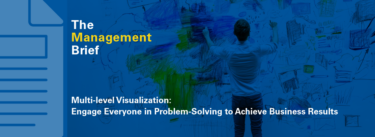Hospitals and healthcare organizations across the country have been implementing lean practice into their work, but not without some resistance. The standard cry is heard, “People are not cars!” How can you standardize good medical practice, naysayers claim, when each person presents a unique set of circumstances that must be attended to on a case by case basis?
While human beings are certainly unique creatures and a hospital is not a production line, our current experience fighting the Ebola virus brings out the reality that much of the work in healthcare can and should follow standard practice.
Dr. Atul Gawande, author of The Checklist Manifesto whose research center has advised the Centers for Disease Control and Prevention on the design of its checklists, pointed out how because of the case in Dallas “hospitals across the country are now scrambling to get their procedures in place.” But these procedures are still difficult to understand and to perform without a good training method. And with a virus as dangerous as Ebola, even a minute mistake or failure can prove fatal.
Many members of the lean community have noted that the TWI training method, used consistently and skillfully by Toyota since the early 1950s to create and sustain standard work practices, might be just the thing for public health concerns like this one.
As a TWI trainer I have been working for over five years with hospitals to introduce this method and got a chance just recently got the chance to “break down” the procedure for doffing (taking off) soiled PPE (Personal Protective Equipment) at a large healthcare network in the Mid-South. This is the most critical part of caring for Ebola patients since it is here that the virus has the opportunity of moving into the body of the healthcare worker (HCW). Body fluids carrying the virus will adhere to the PPE during care and these garments must be removed with precision and in a strict sequence so as not to allow the virus to come into contact with the HCW’s exposed skin or mucous membranes in the eyes, nose and mouth.
Before I arrived, workers at the hospital’s Emergency Department had been trained on a procedure that was closely modeled after the updated CDC guidelines for donning and doffing PPE. Since the equipment each facility has available varies, the procedure will change somewhat to accommodate those differences. For example, in our case we had surgical helmets with a battery pack and fan installed to blow air down the suit to keep the HCW cool. In spite of having a defined procedure, when the head of the ED was called upon to demonstrate the method during the initial training session, he found it difficult to understand and tricky to perform. Simply talking a group of people through the guidelines was not enough to insure full compliance.
In the TWI method, the trainer will prepare a Job Instruction Breakdown Sheet which extracts a “few and simple” words from the job method to say while demonstrating the job. This may sound easy, but finding the best words that describe the job method without confusing the learner takes great skill. For example, the CDC guideline explains the procedure for removing the gown as follows:
- Remove Gown or Coverall: Remove and discard.
- Depending on gown design and location of fasteners, the healthcare worker can either untie fasteners, have the doffing assistant or “buddy” unfasten the gown, or gently break fasteners. Avoid contact of scrubs or disposable garments with outer surface of gown during removal. Pull gown away from body, rolling inside out and touching only the inside of the gown.
In our TWI breakdown, while following the guidelines exactly, we tried to be more specific taking into considering the type of gown our people would be using and giving learners short easily remembered phrases instead of long sentences.
|
IMPORTANT STEPS |
KEY POINTS |
|
|
In addition to demonstrating the job while giving the Important Steps and then again stressing the Key Points, the trainer will do the job yet again giving the reasons for these Key Points. For example, when we explain why doing the job this way helps us “avoid contact of scrubs… with outer surface of gown during removal.” In other words, the trainer teaches in such a way that the learner can clearly, quickly, and easily grasp the What, the How and the Why of doing the job while seeing it performed. And seeing it performed several times.
Other steps in the CDC guideline were not as descriptive and we felt we had to give clearer instructions.
Step 10, Remove Surgical Hood, says to Unfasten (if applicable) surgical hood, gently remove, and discard. No further explanation is given, but our people felt that if the HCW lifted the hood up and off the head this would allow any debris to fall back down on the person’s face, the most vulnerable part of the body! We practiced this part of the job and came up with the following Key Points:
|
IMPORTANT STEPS |
KEY POINTS |
|
|
One breakthrough we had was when we noticed that certain things happened repeatedly after removal of each item. The HCW had to disinfect their gloves after each removal using an “EPA-registered disinfectant wipe or ABHR.” We also felt the need to emphasize discarding each of these items immediately into an appropriate receptacle and then physically moving (taking a step over) to a new clean surface to stand on. By using the concept of Common Key Points, items that are critical to the whole job rather than any individual step, we were able to teach these points once instead of repeatedly throughout the course of the task. In this way, we were able to cut the number of steps in half: from 21 to 9.
|
IMPORTANT STEPS |
KEY POINTS |
|
AFTER EACH STEP:
|
While all of these Key Points are performed after each step of the overall process, by separating them from the flow of the work, the procedure is much easier to grasp and retain. Moreover, because of the critical nature of the procedure it is always done with an observer who can ensure that no detail is missed and help out with the doffing if necessary. The entire breakdown for the work at this particular hospital, bearing in mind that this is a first draft and still needs to be tested and modified, looked like this:
|
IMPORTANT STEPS |
KEY POINTS |
|
Must engage observer in each step AFTER EACH STEP:
|
|
|
|
|
|
|
|
|
|
|
|
|
|
|
|
|
|
|
It is very important to note that we were and are not trying to replace the CDC guidelines with the TWI breakdown.
In manufacturing settings we hear people say that because they now possess Job Instruction Breakdowns Sheets they can now throw away their SOPs (Standard Operating Procedures). Absolutely not! The breakdown sheet is a tool for training and is designed to allow trainers to skillfully teach a job while demonstrating the method. It is both what the learner hears and sees that constitutes the whole of the training and, for that purpose, the breakdown does not contain every detail of the job and is not a complete record of the method. Both trainers and learners alike can and should study the more complete guidelines and procedures but they do not replace good training practice. It is when we rely solely on these detailed procedures that training is incomplete and confusing.
The CDC recommends that hospitals “train healthcare workers on all PPE recommended in the facility’s protocols” and that these workers “must demonstrate during the training process competency” in the tasks. The question is whether an effective training method that achieves this goal is available. And this is the same question all organizations striving to implement lean practice ask when they struggle to achieve and sustain standard work practices. Whether in healthcare or manufacturing, TWI provides the basic skills to create a solid foundation of stability and consistency where it is needed most.





